White ducks are among the most common types of ducks in North America and among the most common domesticated ducks in the world.
Various species of ducks that are almost entirely white are seen around the world.
From species that are found in captivity to ducks that live along coastal areas, these ducks come in all shapes and sizes.
The history of domestic ducks goes back hundreds of years. The advent of colonial migration has spread white ducks around the world also marking a period when many became domesticated.
White ducks were always seen as good species to raise for meat.
While the 18th and 19th century marks the first times these ducks were introduced around the world at scale, there’s evidence to show they were used for meat long before this period.
The following ducks impress with their overall white appearance and even high color variation within the same species.
As an example, Indian Runner Ducks are known to come in white and tens of other colors.
Here are some of the typical white ducks of the world. Many of these species are inter-connected as there are hybrids.
Table of Contents
1. American Pekin

For years, The American Perkin was the most common duck in North America and it still remains one of the most common ducks on the continent.
These ducks are some of the most common domesticated all-white ducks and ducks, in general, in North America.
With a white head, breast, belly, and wings, the ducks only show orange beaks and legs.
The American Pekin is named after the old name of Beijing since these species originate in China.
They might also be locally known as The Long Island Ducks are they’ve made their way to The US through Long Islands.
An initial batch of just a few American Pekins making their way to The US eventually spread to be mostly raised for meat and less for eggs around the continent.
Range –domestic
2. Call Duck
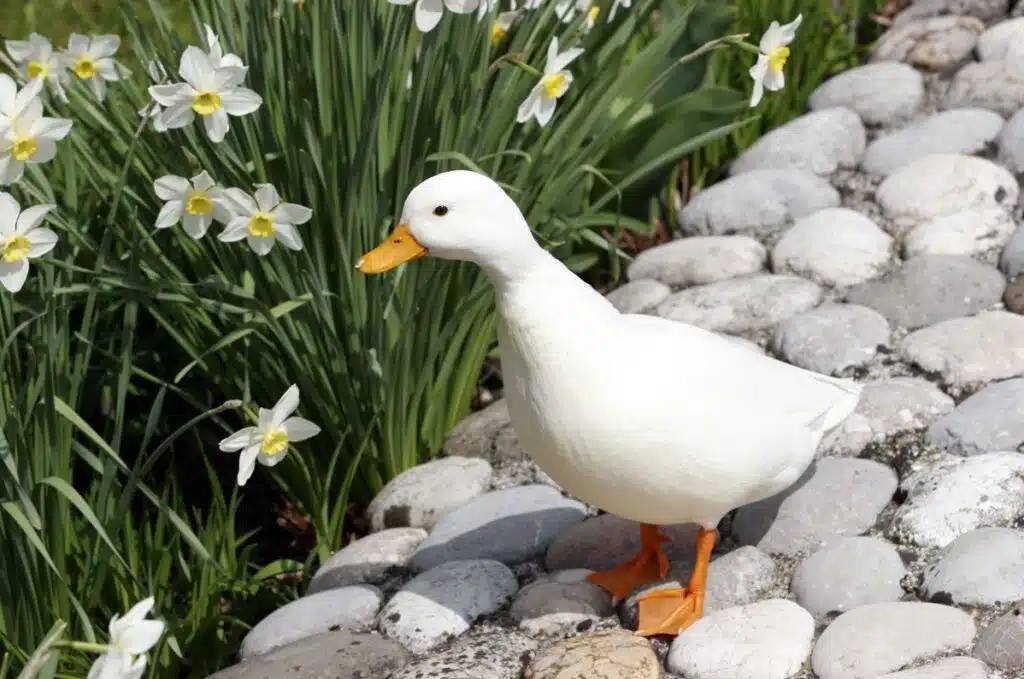
A very similar species to The American Pekin, Call Ducks are also mostly white with an orange beak and orange legs.
Unlike The American Pekin, Call Ducks also come in a considerably-larger number of colors around the world.
There’s no universal absolute when it comes to its official number of colors.
Apart from its white color, there are 5 other colors this species comes in, recognized in The United States.
It’s believed there are more than 20 Call Duck colors but the white morph continues to be the most common.
Range – domestic
3. Aylesbury Duck
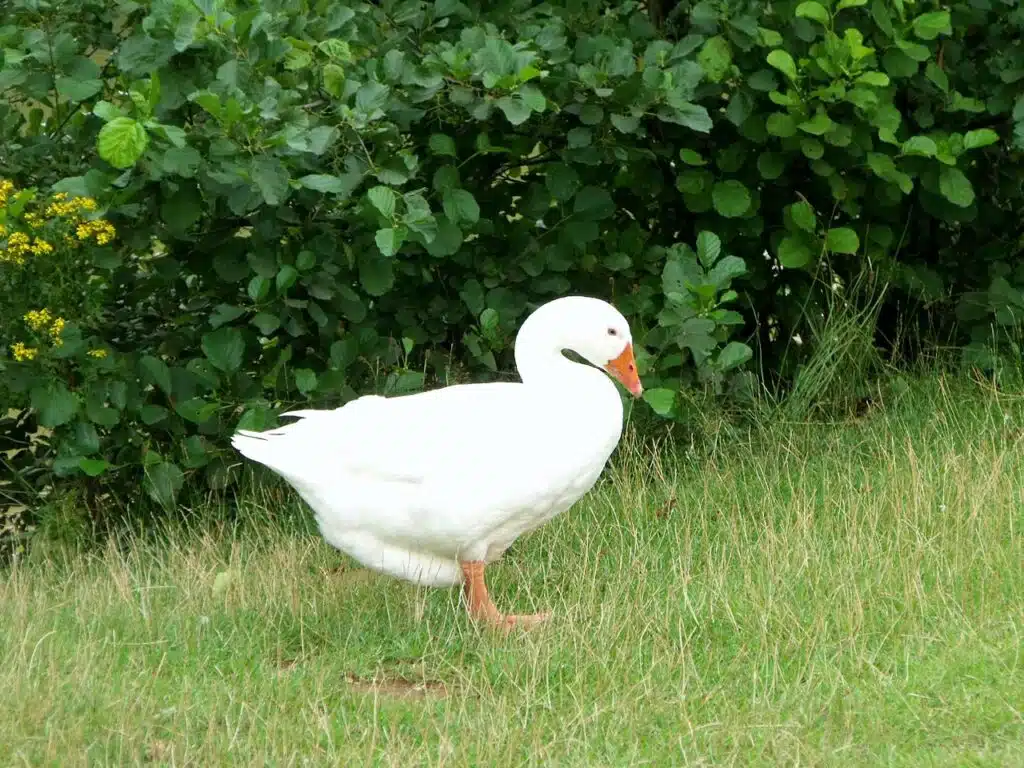
Aylesbury Ducks are somewhat similar to Pekin Ducks. But it’s not only their physical white plumage that gets these species together.
Like many other types of common local meat ducks, Aylesbury Ducks have been replaced by the imported Pekin Ducks.
Aylesbury Ducks are named after their range in the Aylesbury region of The British Isles.
It’s here that these ducks were a dominant species of ducks for meat.
When the American Pekin was introduced, the local Aylesbury Ducks started breeding with them, eventually ending in mixed populations.
The final result is that Aylesbury Ducks slowly become replaced.
While the species was also introduced to The United States, it didn’t enjoy the same explosive-grown Peking Ducks did.
Range – domesticated
4. Crested Duck
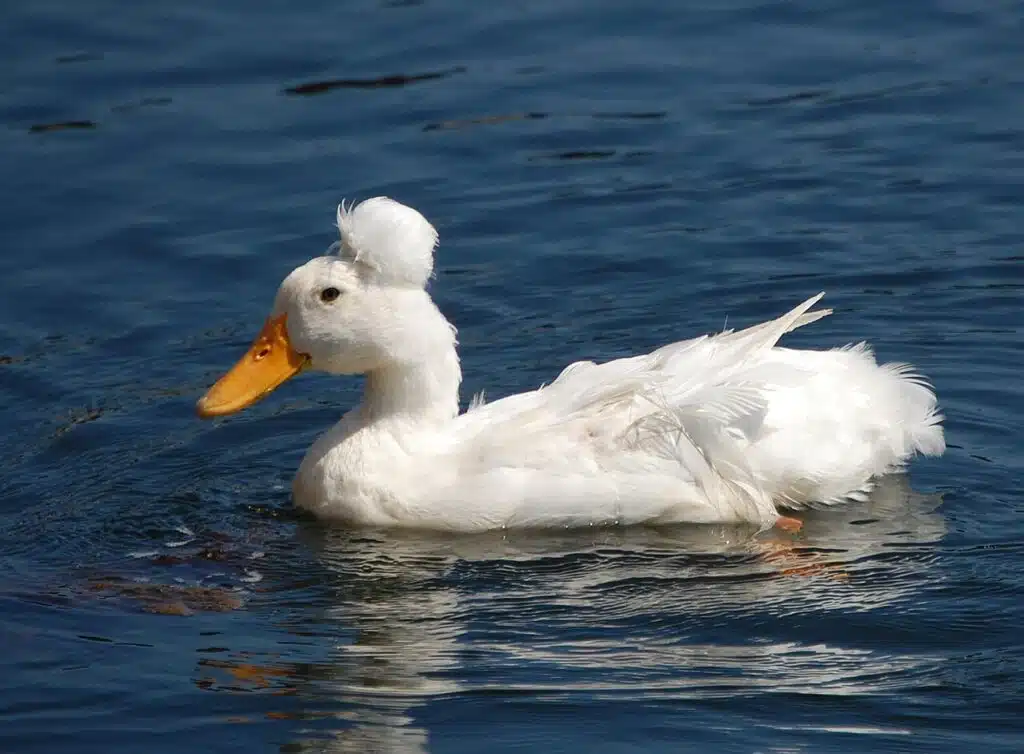
Named after an unusual globe-shaped crest, this type of duck is also completely white.
It shares a bright orange beak with other white ducks such as The American Pekin.
Even more, the crest itself also serves as a fat reserve which may or may not interfere with brain function, depending on its size.
The actual size of the crest also impacts if the duck may lose motricity abilities when interfering with the brain.
White and black Crested Ducks are recognized in The United States. It’s here that these ducks are used as decoration on ponds.
Its reduced size doesn’t place it among the species that are the first choice among white domesticated ducks.
Multiple other colors are recognized for Crested Ducks outside of The United States.
Range – North America, Europe
5. German Pekin
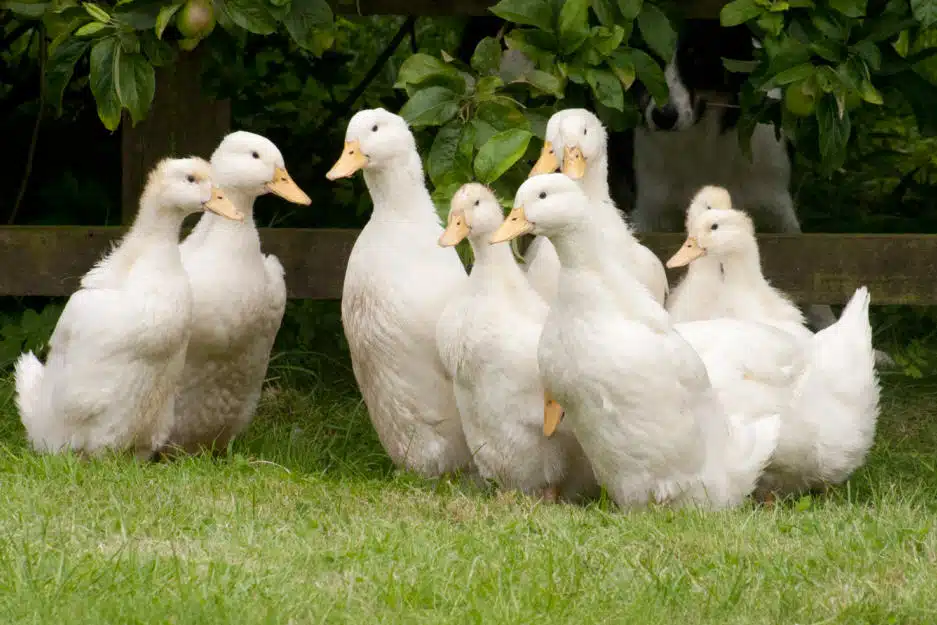
The European counterpart of The American Peki, The German Pekin is also a descendant of Chinese ducks.
First introduced in Germany, this is an adapted species with white plumage and yellow-orange beaks.
Even the white plumage of The German Pekin has a slight yellow tinge.
The introduction of the duck to Europe was initially based on its meat production.
It turns out other ducks were more tasty and they eventually became a species that were acquired for ponds, as show ducks.
Range – domesticated in Europe
6. Golden Cascade
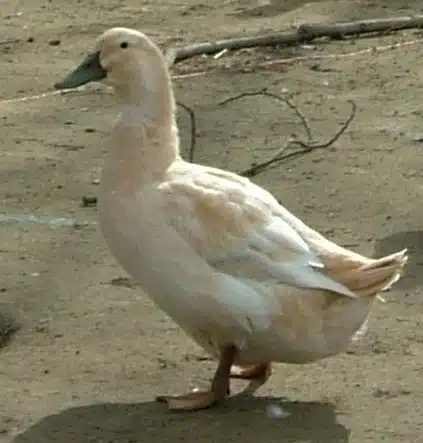
A medium-sized duck, Golden Cascades are known for their mostly white coloring. Brown overlays may also be seen on its plumage.
This type of duck has been introduced to The United States more recently. Its main purpose was to be the species with the fastest growth and with excellent egg-laying capacity.
Since its introduction in the ‘70s, this duck has been accepted around the country under its different colors.
While mostly white, Golden Cascades can be slightly brown, gray, or even green-tinged.
Its beak is orange or green as well.
Golden Cascades can be grown in all US states as these ducks are highly adaptable.
The species grows to a maximum of 8 pounds and it can be grown both for meat and for eggs.
Range – domestic
7. Mulard
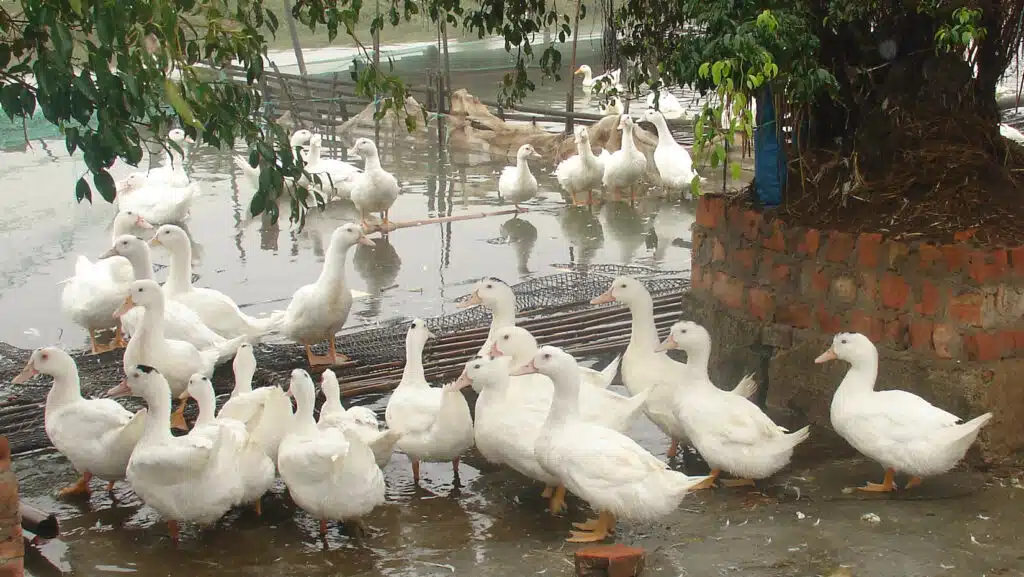
Mulards are a type of hybrid duck with all-white plumage. These types of ducks only have a pale yellow beak with black margins to contrast their white appearance.
Mulard ducks are a hybrid between Muscovy ducks and Domestic ducks.
These are also domestic ducks grown around the world for meat, eggs, or for show.
Ducks of this family do have a wild ancestor. Mallards are their wild ancestor which is not all-white.
A mulard is a type of sterile duck that can only reproduce through artificial insemination, as its name suggests.
While common in The US, Mulards are mostly grown in France for meat where they are seen as a delicatessen.
Range – domestic
8. Ancona Duck
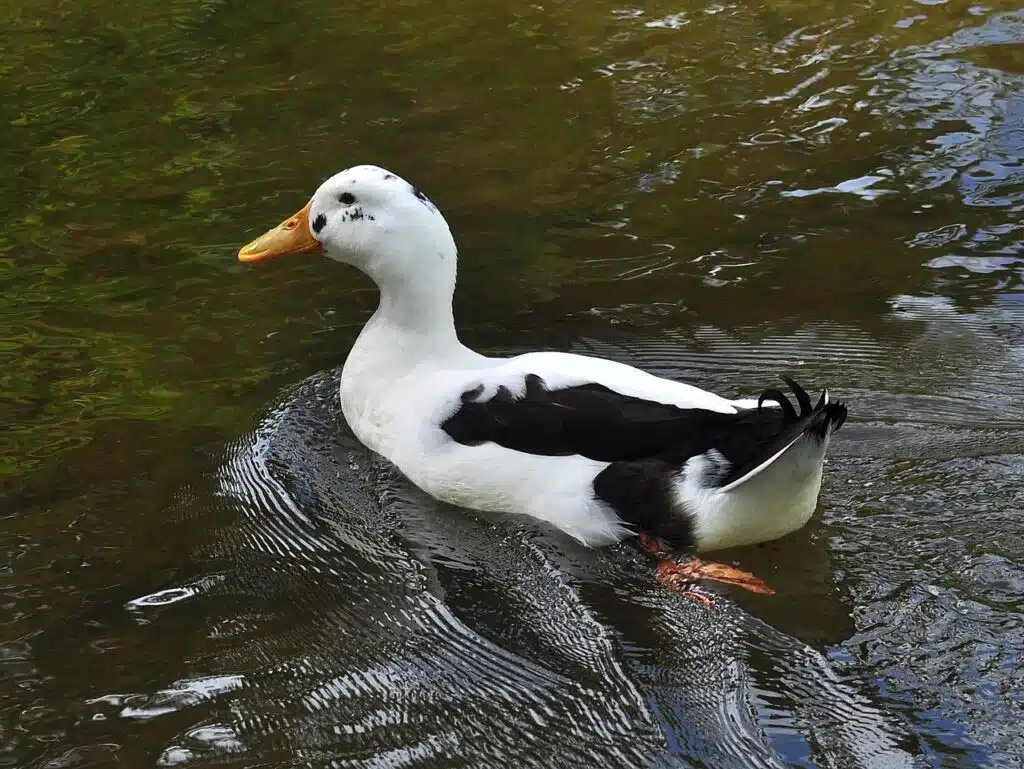
Ancona Ducks are mostly white. They have a white head, a white neck, a chest, bellies, and a white back. Its wings are mostly black with just a few white patterns.
Small black dots and spots are further distinguished on their heads.
A few variants of this species may also show additional black spots. The front part of the neck and the chest tend to be the areas where extra black dots can also be seen.
This species may also lay eggs of various colors also showing spots.
Ancona Ducks are also known to be prolific breeders. They can lay almost 300 eggs in a year with some ducks laying an average of almost 1 egg per day.
While the ducks are white with black spots, their eggs can be blue or green.
Range – domestic
9. Bali Duck
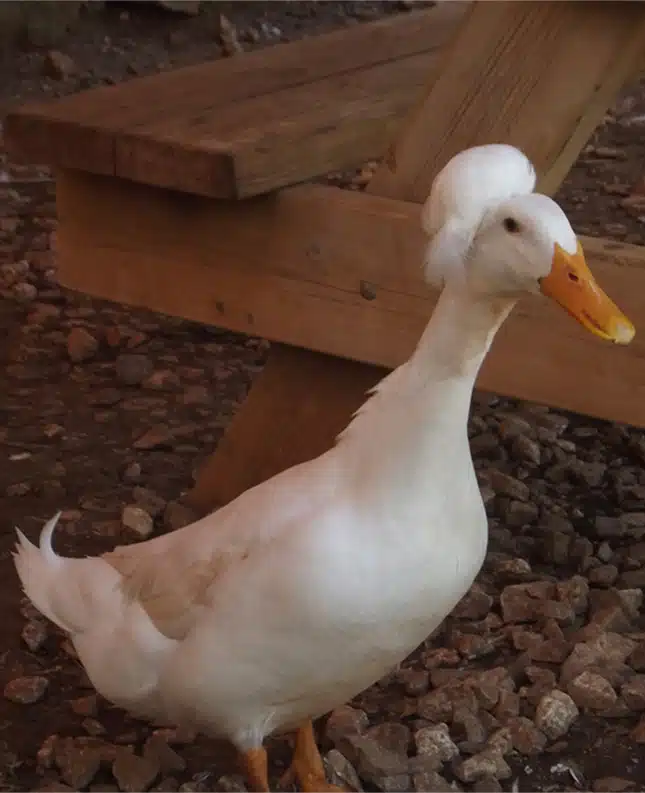
A crested species of Bali, these types of ducks are only seen in Bali and rarely in other parts of the world.
Dominated by a white appearance, these ducks further show a yellow-orange beak and a large white crest. In rare cases, the duck can also be seen without a crest.
As with other ducks with crests, it’s the same crest that may trigger various diseases in the species. An actual lump of fat, this crest may be too large and impact the brain.
By some studies, this crest is actually a predisposition through a gene.
This means the crest may pass down to ducklings. In this case, Bali Duck ducklings can be born with certain physical defects which means the species never represented much interest to those raising them for show.
As a result, Bali Ducks are mostly seen in Bali. It’s on these islands that the duck is seen as a pet, rather than a meat duck.
Range – Bali
10. Indian Runner Duck
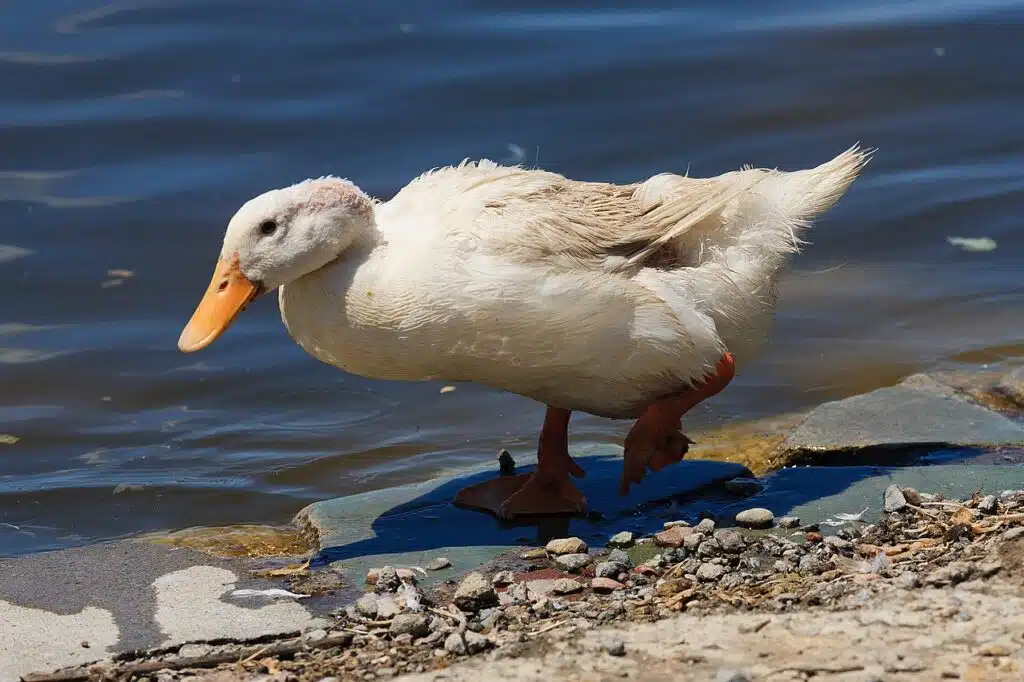
One of the first imported ducks in The United States is The Indian Runner Duck.
This is a species that was known under different names, including The Penguin Duck. This name was inspired by the erect standing position of the duck.
A thin duck that sits upright, this species is also seen in white, in accordance with other coloring and morphs.
Some of the particularities of the species also include having a high and straight dark beak as well as a shorter tail.
However, the high color variation remains a particularity The Indian Runner Duck is mostly known for.
It comes in plain colors such as white, as well as in color combinations, striped appearance, and even in a spotted appearance.
Unlike other species, The Indian Runner Duck may show high color variation even among small groups of ducks.
This duck is believed to be a great meat source, often being priced higher than other meat ducks.
Range – domestic
11. White Silky Ducks
Silky Ducks (not to be confused with silky chicken), are types of ducks that come in different colors. A white morph is as common as the black morph of the species.
This feathery white morph is complete by a bright orange beak and bright orange legs.
Silky Ducks that are mostly white also come in different other color combinations which aren’t all-white as White Silky Ducks.
This includes the common Snowy Silky Duck. This is a morph with almost all-white coloring but where the head has a yellow-golden nuance and where the tail is also partially black.
Range – domestic
12. White Muscovy Duck
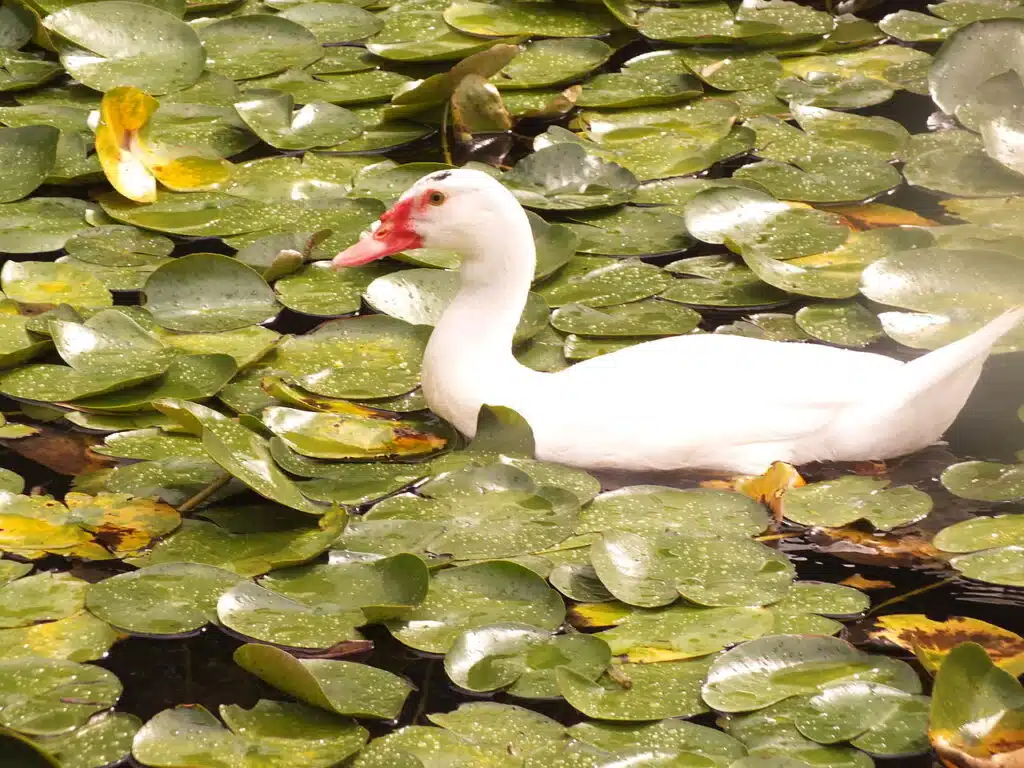
White Muscovy Ducks are among the few white ducks that are still found in the wilderness.
The history of the species is highly atypical. First discovered along Brazilian rivers, The White Muscovy Duck is a species that has only been domesticated after being introduced to Europe.
It’s here that it can be found along rivers, particularly in riparian areas.
White Muscovy Ducks can be identified by their white, off-white, or white-to-cream color.
Unlike other white ducks, these ones also show a red skin exposed skin area on the face.
Found both in the wilderness and in captivity as a domesticated species, White Muscovy Ducks like trees in their habitat which they perch on.
Range – Brazil, Germany
13. White Layer Duck
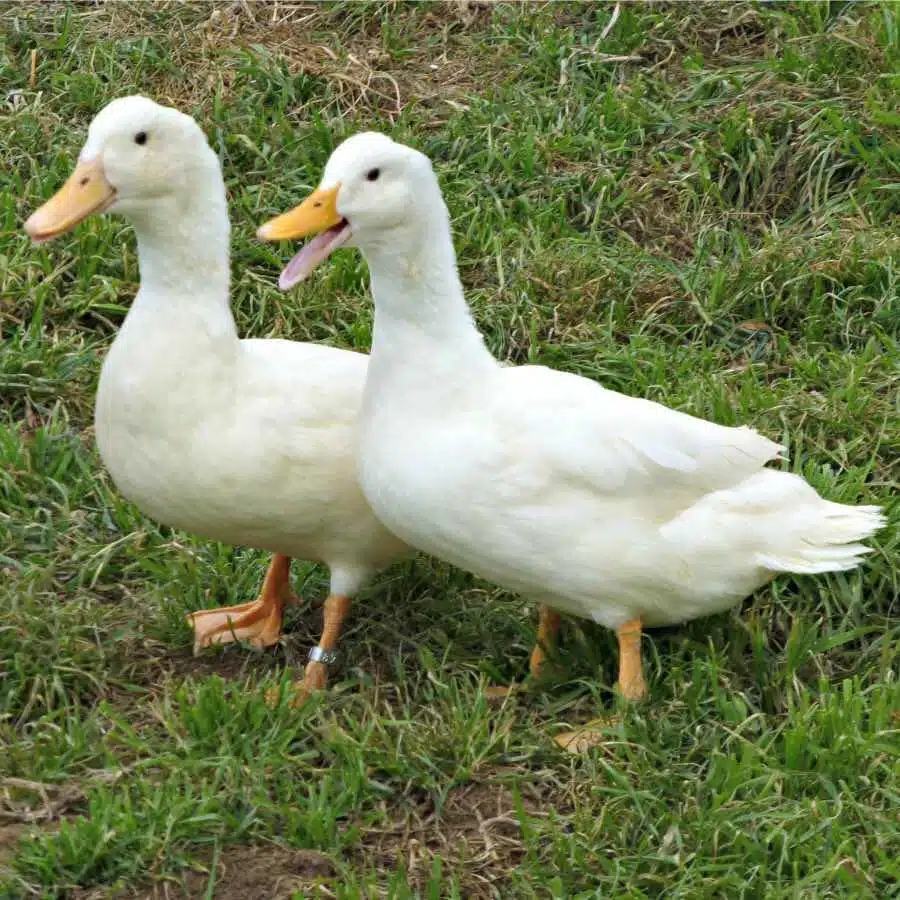
White Layer Ducks are highly prized in capacity in North America.
Some types of pet owners prefer to see these ducks simply as pets, but they are some of the most productive meat ducks in the world.
A mostly white appearance with a bright orange beak is specific to this species which also shows an upward-facing tail.
These white ducks are known to be very docile, which is why they are highly common on farms with other animals or with children.
Their egg-laying numbers are also impressive. Some of the most productive White Layer Ducks can lay up to 300 eggs per year.
Range – domestic
14. Bourbourg Duck
Bourbourg Ducks are named after the city they were first traded in 19th-century France.
This is a species that’s almost completely white, apart from its beak and legs.
Tender meat has made Bourbourg Ducks a delicatessen in France and elsewhere around Europe.
These types of ducks don’t lay many eggs, and typically retail at a higher price than others. Even the most productive Bourbourg Ducks only lay up to 50 eggs per year.
Identified by its white roughed tail, The Bourbourg Duck has been highly popularized when Bourbourg became a market town.
The species was sold here where it quickly spread around the region.
These types of ducks can theoretically be raised anywhere in temperate climates. In reality, the species like coastal areas, such as those in its native Northern France.
While it eats insects and other foods, it prefers coastal grasses on which it thrives.
Highly docile, these ducks are known to follow their owners around. A species that’s easy to raise, Bourgbourg Ducks show an atypical closeness to the owner.
As a result, they are often recommended to raise families with children.
Range – Northern France